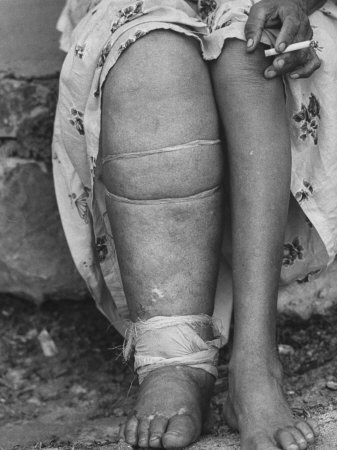Disease Lymphatic filariasis or elephantiasis can be instantly recognizable from the shape of the foot or arm with an enlarged.
The disease is caused by parasitic worms, including Wuchereria bancrofti, Brugia malayi and Brugia timori, all transmitted by mosquitoes.
This disease has struck more than 120 million people in the world. When an infected female mosquito bites a person, the larvae, called microfilariae spread in the bloodstream, the larvae can live for many years.

the effects of this disease often only comes after a year are infected.
Prevention.
Prevention can be done by:
A. Trying to avoid the bite of infectious mosquitoes.
B. Clean water plants in the marsh which is where the brood of mosquitoes, stockpiling, drying or draining standing water as a mosquito brood.
C. Clean up the bushes around the house.





The disease is transmitted by mosquitoes which suck the blood of someone who had contracted earlier. Infected blood and contain larvae and would be transmitted to others when an infected mosquito bite or suck the blood of the person.
Unlike malaria and dengue fever, filariasis can be transmitted by 23 species / species of the genus Anopheles mosquito, Culex, Mansonia, Aedes and Armigeres. Because of this, filariasis can spread very quickly.
In Indonesia the disease elephantiasis widespread throughout the province. Based on the results of the last survey in 2000 recorded 1553 in 647 rural health centers and 26 provinces as the location of endemic, with a number of chronic cases, there were 6233 people.
Clinical Symptoms
Acute symptoms of filariasis or elephantiasis are:
Fever over and over again for 3-5 days, fever may be lost when a break and came back after working hard.
Swollen lymph nodes (no injuries) groin area, armpits (lymphadenitis), which looks red, hot and sore.
Tract inflammation of lymph nodes that were hot and the pain radiating from the base of the foot or base of the arm towards the end (retrograde lymphangitis)
Filarial abscess due to frequent suffering from swollen lymph nodes, may rupture and ooze pus and blood.
Enlargement of the legs, arms, breasts, testicles (elephantiasis skroti)
Diagosis
- Prepaten period: 8-16 months.
- The main complaint / principal
- Acute:
- Selfagia
- Anorexia
- Shiver
- 3-5 days of fever, irregular intervals.
- Chronic:
- Growing extremity (elephantiasis).
- Complication
- Hydrocele.
Kiluri
Kiloasites. - Management / treatment
- General Therapy
Break
- Bed rest in acute circumstances.
- Elastic bandage to hold edema, elephantiasis
- Fabric backing for orchitis and epididymitis.
- Diet
- Medical
- Drugs First
- Diethylcar bamazine (DEC), the drug of choice. Dose of 3 × 2 mg / day, starting a small dose and then increased 3 × 3 mg for 21 days.
- DEC for mass therapy: 100 (1 tablet) per week uyntuk age> 10 years for 40 weeks to age> 2-9 years 50 mg (½ tablet)
- Ivermectin. A single dose of 200 / kg followed by 400, still to DEC.
- Antimicrobial when there is secondary infection. Alternative Medicines Surgery in certain cases.
No comments:
Post a Comment